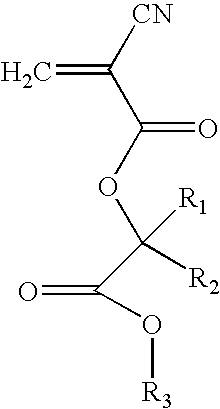Adhesive-Containing Wound Closure Device and Method
a wound closure and adhesive technology, applied in the field of medical and surgical wound closure and management, can solve the problems of additional pain and trauma to patients, cosmetically unattractive wound closure marks, and additional trauma to patients, so as to improve the approximation of wounds, improve the durability of microbial barriers, and improve wound closure.
- Summary
- Abstract
- Description
- Claims
- Application Information
AI Technical Summary
Benefits of technology
Problems solved by technology
Method used
Image
Examples
example 1
[0102]The working and setting times of the inventive composite device, using a flexible textile material and a cyanoacrylate polymerizable adhesive formulation, are compared to the working and setting times of conventional available cyanoacrylate devices. The conventional available cyanoacrylate devices used are the DERMABOND® topical skin adhesive products comprising a polymerizable monomer dispersed from an applicator having a porous tip containing polymerization initiator. Two DERMABOND® adhesive formulations are tested namely, a low viscosity adhesive formulation, referred to here as DERMABOND LV and a high viscosity adhesive formulation, referred to here as DERMABOND HV (both manufactured by Closure Medical Corporation and available from Ethicon). The composite devices of the present invention are also prepared using the cyanoacrylate polymerizable adhesive compositions of the DERMABOND LV and DERMABOND HV formulations, with the cyanoacrylate polymerizable adhesive compositions...
example 2
[0112]The tensile strength of film samples of DERMABOND LV adhesive are compared to the tensile strength of Composite A, described in Example 1 above.
[0113]Thin films of DERMABOND LV adhesive are prepared by expressing the adhesive from a DERMABOND LV applicator onto a glass plate. Subsequently, a second glass plate of the same size is placed on top of the adhesive such that the adhesive is pressed between the two plates. Once the adhesive polymerizes, the glass plates are separated and the film of adhesive is removed. This film was then cut into strips with dimensions 4.0 inch×0.5 inch. Ten DERMABOND LV film strips are thus prepared.
[0114]Strips of Composite A are prepared using SPECTRA MESH® filtration material loaded with initiator by dip coating in an 0.1 M solution of BHC in methanol, as described above. Dip coated strips are allowed to dry for 24 hours prior to their use. Mesh strips, measuring 4.0 inch×0.5 inches, are saturated with DERMABOND LV adhesive by expressing the adh...
PUM
 Login to View More
Login to View More Abstract
Description
Claims
Application Information
 Login to View More
Login to View More - R&D
- Intellectual Property
- Life Sciences
- Materials
- Tech Scout
- Unparalleled Data Quality
- Higher Quality Content
- 60% Fewer Hallucinations
Browse by: Latest US Patents, China's latest patents, Technical Efficacy Thesaurus, Application Domain, Technology Topic, Popular Technical Reports.
© 2025 PatSnap. All rights reserved.Legal|Privacy policy|Modern Slavery Act Transparency Statement|Sitemap|About US| Contact US: help@patsnap.com

